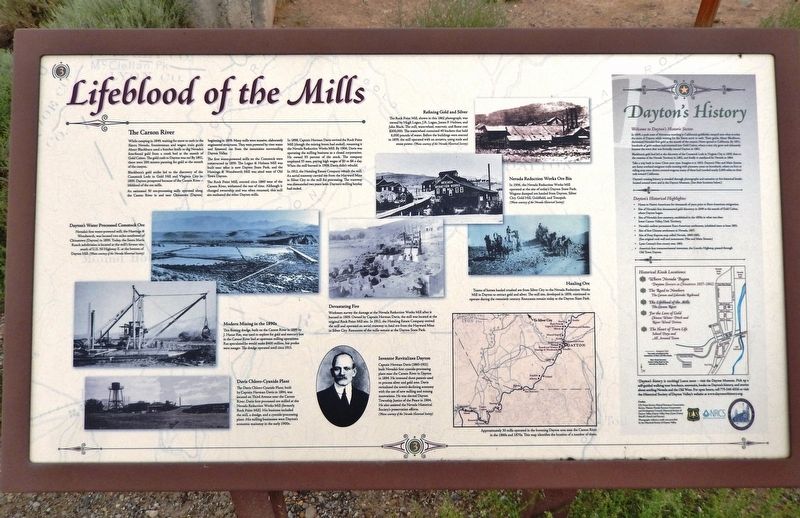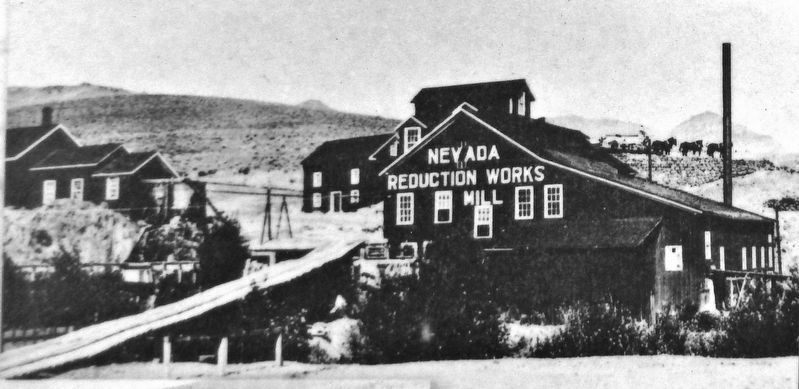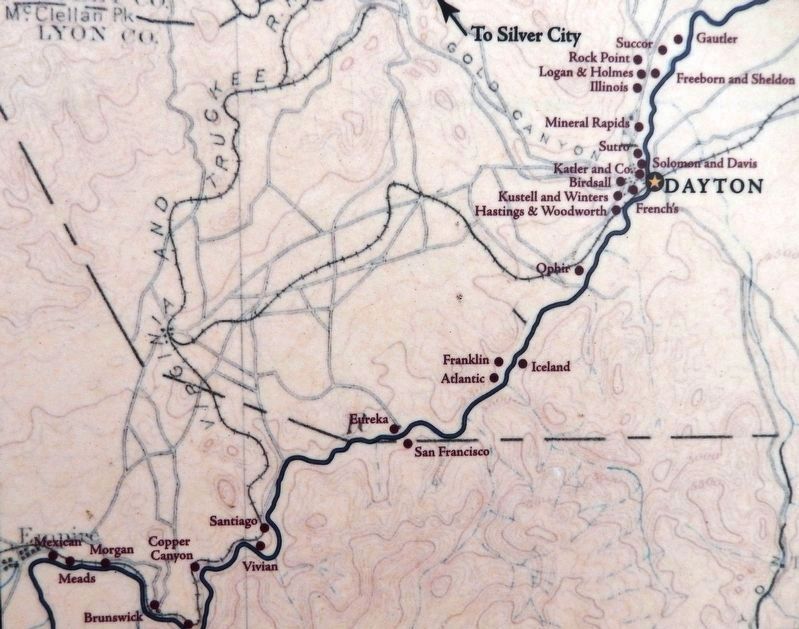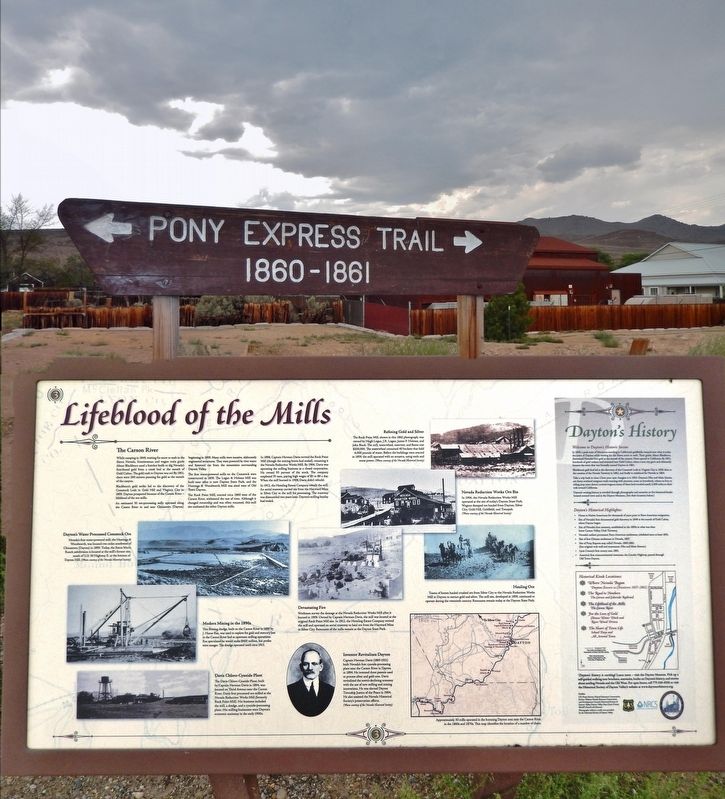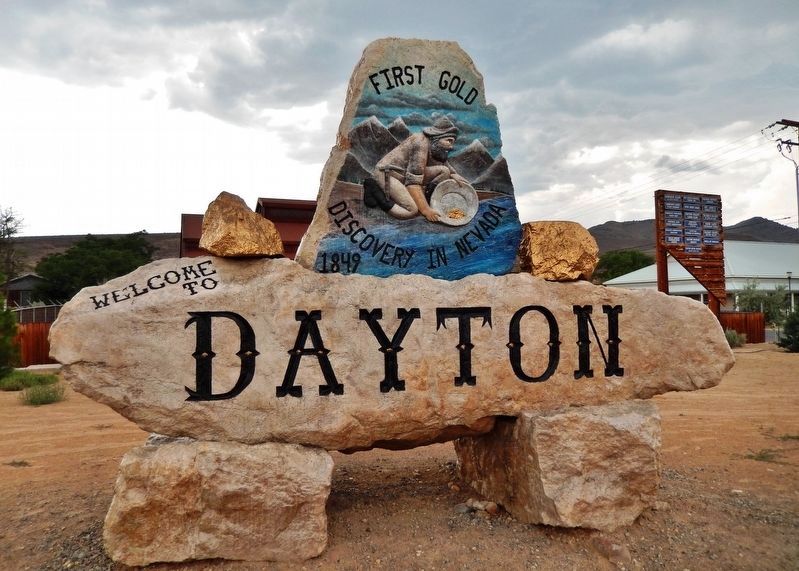Dayton in Lyon County, Nevada — The American Mountains (Southwest)
Lifeblood of the Mills
Dayton's History
The Carson River
While camping in 1849, waiting for snow to melt in the Sierra Nevada, frontiersman and wagon train guide Abner Blackburn used a butcher knife to dig Nevada's first-found gold from a creek bed at the mouth of Gold Cañon. The gold rush to Dayton was on! By 1851, there were 200 miners panning for gold at the mouth of the canyon.
Blackburn's gold strike led to the discovery of the Comstock Lode in Gold Hill and Virginia City in 1859. Dayton prospered because of the Carson River — lifeblood of the ore mills.
An estimated 30 ore-processing mills operated along the Carson River in and near Chinatown (Dayton) beginning in 1859. Many mills were massive, elaborately engineered structures. They were powered by river water and firewood cut from the mountains surrounding Dayton Valley.
The first water-powered mills on the Comstock were constructed in 1859. The Logan & Holmes Mill was built near what is now Dayton State Park, and the Hastings & Woodworth Mill was sited west of Old Town Dayton.
The Rock Point Mill, erected circa 1860 west of the Carson River, withstood the test of time. Although it changed ownership and was often renamed, this mill site outlasted the other Dayton mills.
In 1898, Captain Herman Davis revived the Rock Point Mill (though the mining boom had ended), renaming it the Nevada Reduction Works Mill. By 1906, Davis was operating the milling business as a closed corporation. He owned 93 percent of the stock. The company employed 55 men, paying high wages of $3 to $8 a day. When the mill burned in 1909, Davis didn’t rebuild.
In 1912, the Hotaling Estate Company rebuilt the mill. An aerial tramway carried ore from the Hayward Mine in Silver City to the mill for processing. The tramway was dismantled two years later. Dayton's milling heyday had ended.
[sidebar] Dayton's History
Welcome to Dayton's Historic Sector.
In 1849, a pack train of Mormons traveling to California's goldfields camped near what is today the town of Dayton while waiting for the Sierra snow to melt. Their guide, Abner Blackburn, discovered Nevada's first gold at the mouth of the canyon. News spread to California. By 1851, hundreds of gold-seekers had swarmed into Gold Canon, where a tent city grew and ultimately became the town that was formally named Dayton in 1861.
Blackburn's gold find led to the discovery of the Comstock Lode in Virginia City in 1859, then to the creation of the Nevada Territory in 1861, and finally to statehood for Nevada in 1864.
Take a trip back in time: Close your eyes. Imagine it is 1853. Dayton's Pike and Main Streets are dusty overland emigrant trails teeming with pioneers, some
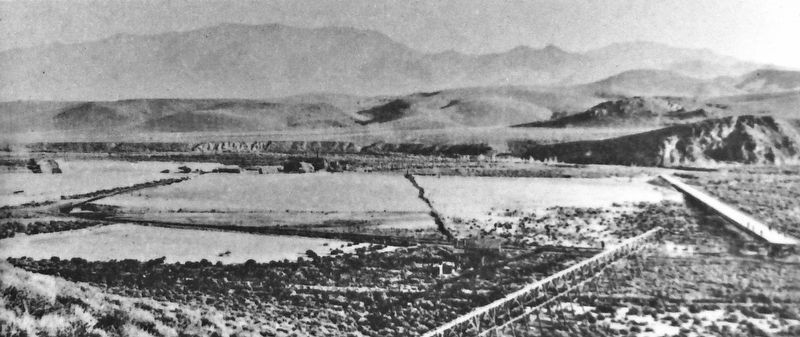
Courtesy Nevada Historical Society
2. Marker detail: Dayton's Water Processed Comstock Ore
Nevada's first water-powered mill, the Hastings & Woodworth, was located two miles southwest of Chinatown (Dayton) in 1859. Today, the Santa Maria Ranch subdivision is located at the mill's former site, south of U.S. 50 Highway E. at the bottom of Dayton Hill.
Dayton's rousing history is revealed through photographs and narrative on five historical kiosks located around town and in the Dayton Museum. (See their locations below.)
Dayton’s Historical Highlights:
• Home to Native Americans for thousands of years prior to Euro-American emigration.
• Site of Nevada's first documented gold discovery in 1849 at the mouth of Gold Cañon, where Dayton began.
• Site of Nevada's first cemetery, established in the 1850s in what was then lower Carson Valley, Utah Territory.
• Nevada's earliest permanent Euro-American settlement, inhabited since at least 1851.
• Site of first Chinese settlement in Nevada, 1857.
• Site of Pony Express stop called Nevada, 1860-1861.
(See original rock wall and monument, Pike and Main Streets.)
• Lyon County's first county seat, 1861.
• America's first transcontinental interstate, the Lincoln Highway, passed through Old Town Dayton.
Erected by U.S. Forest Service, Natural Resources Conservation Service, and Historical Society of Dayton Valley. (Marker Number 3.)
Topics and series. This historical marker is listed in these topic lists: Industry & Commerce
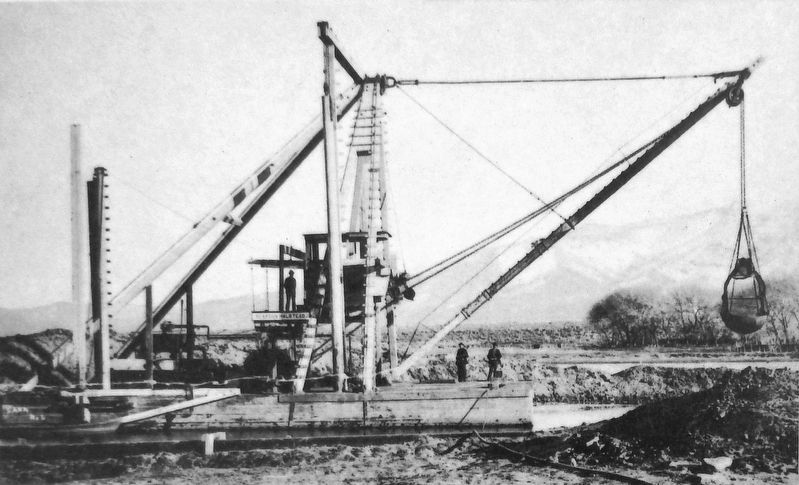
Courtesy Historical Society of Dayton Valley
3. Marker detail: Modern Mining in the 1890s
This floating dredge, built on the Carson River in 1889 by J. Hanse Rae, was used to explore for gold and mercury lost in the Carson River bed at upstream milling operations. Rae speculated he would make $400 million, but profits were meager. The dredge operated until circa 1915.
Location. 39° 14.386′ N, 119° 35.354′ W. Marker is in Dayton, Nevada, in Lyon County. Marker is on Lincoln Highway (U.S. 50) south of 4th Avenue, on the right when traveling south. Marker is located beside the sidewalk, near the "Welcome to Dayton" sign. Touch for map. Marker is in this post office area: Dayton NV 89403, United States of America. Touch for directions.
Other nearby markers. At least 8 other markers are within walking distance of this marker. Camels in Dayton (about 700 feet away, measured in a direct line); Courthouse Site (approx. 0.2 miles away); The Misfits (approx. 0.2 miles away); Dayton's School House - 1865 (approx. ¼ mile away); Odeon Saloon - Billiard Parlour (approx. ¼ mile away); Carson & Colorado Railroad (approx. ¼ mile away); The Road to Nowhere (approx. ¼ mile away); Where Nevada Began (approx. ¼ mile away). Touch for a list and map of all markers in Dayton.
Related markers. Click here for a list of markers that are related to this marker. Dayton's History
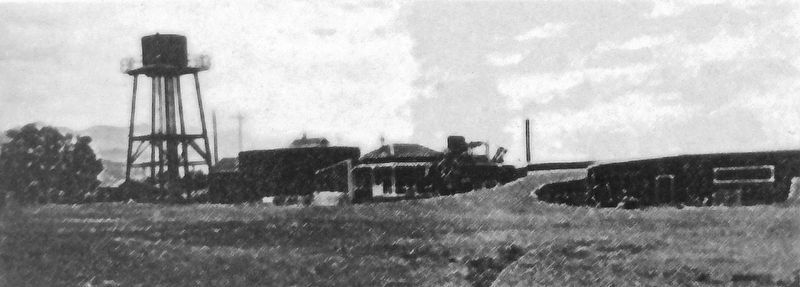
Courtesy Historical Society of Dayton Valley
4. Marker detail: Davis Chloro-Cyanide Plant
The Davis Chloro-Cyanide Plant, built by Captain Herman Davis in 1894, was located on Third Avenue near the Carson River. Davis first processed ore milled at the Nevada Reduction Works Mill (formerly Rock Point Mill). His business included the mill, a dredge, and a cyanide-processing plant. His milling businesses were Dayton's economic mainstay in the early 1900s.
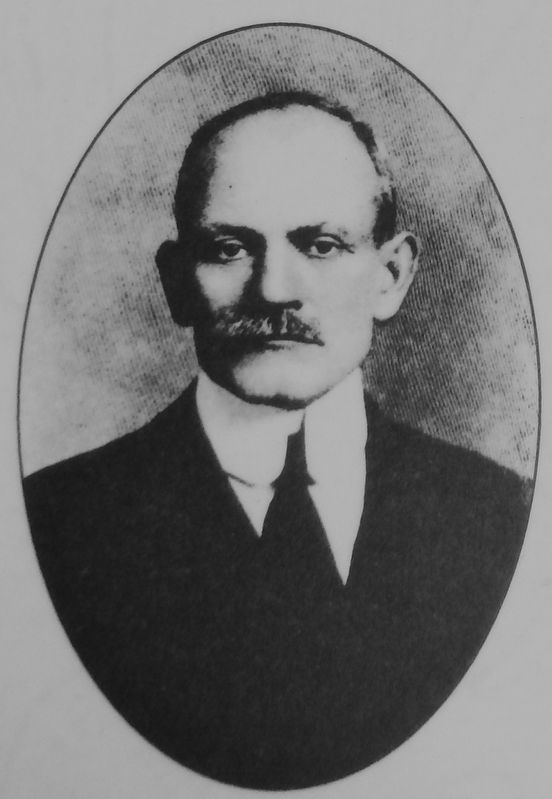
Courtesy Nevada Historical Society
5. Marker detail: Inventor Revitalizes Dayton
Captain Herman Davis (1865-1921) built Nevada's first cyanide-processing plant near the Carson River in Dayton in 1894. He invented three patents used to process silver and gold ores. Davis revitalized the town's declining economy with the use of new milling and mining innovations. He was elected Dayton Township Justice of the Peace in 1904. He also assisted the Nevada Historical Society's preservation efforts.
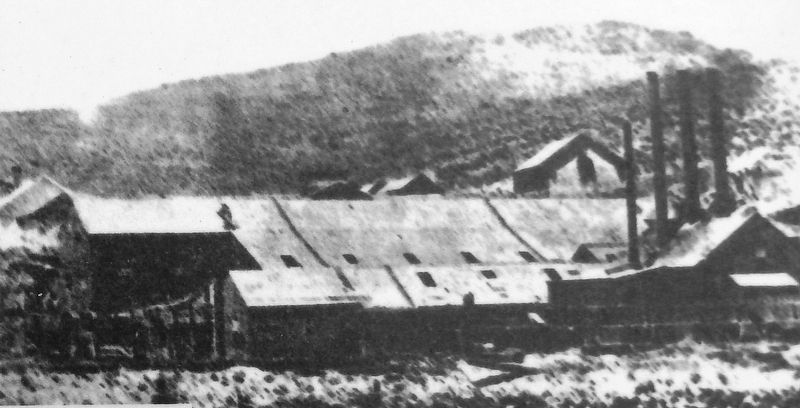
Courtesy Nevada Historical Society
6. Marker detail: Refining Gold and Silver
The Rock Point Mill, shown in this 1862 photograph, was owned by Hugh Logan, J.R. Logan, James P. Holmes, and John Black. The mill, waterwheel, reservoir, and flume cost $200,000. The waterwheel contained 40 buckets that held 6,000 pounds of water. Before the buildings were erected in 1859, the mill operated with an arrastra, using mule and stone power.
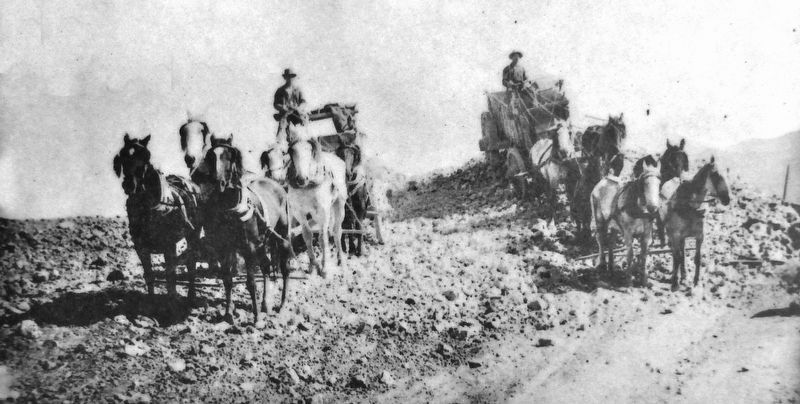
Courtesy Historical Society of Dayton Valley
8. Marker detail: Hauling Ore
Teams of horses hauled crushed ore from Silver City to the Nevada Reduction Works Mill in Dayton to extract gold and silver. The mill site, developed in 1859, continued to operate during the twentieth century. Remnants remain today at the Dayton State Park.
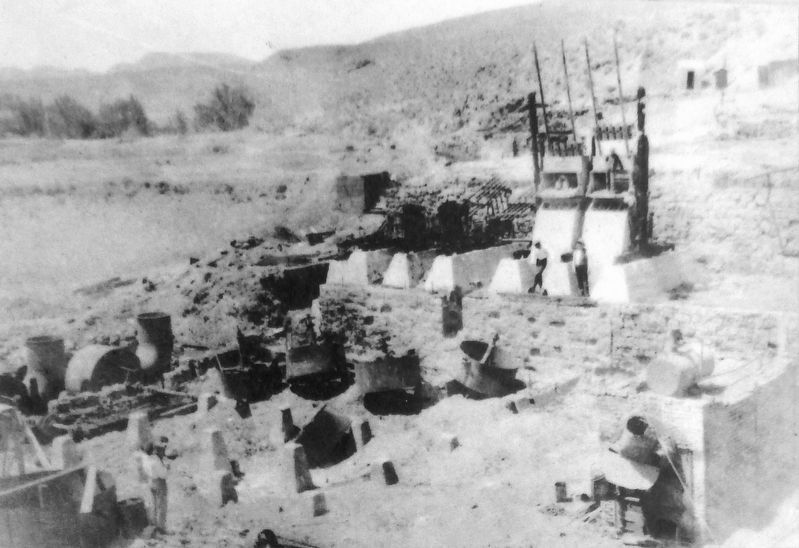
Courtesy Historical Society of Dayton Valley
9. Marker detail: Devastating Fire
Workmen survey the damage at the Nevada Reduction Works Mill after it burned in 1909. Owned by Captain Herman Davis, the mill was located at the original Rock Point Mill site. In 1912, the Hotaling Estate Company revived the mill and operated an aerial tramway to haul ore from the Hayward Mine in Silver City. Remnants of the mills remain at the Dayton State Park.
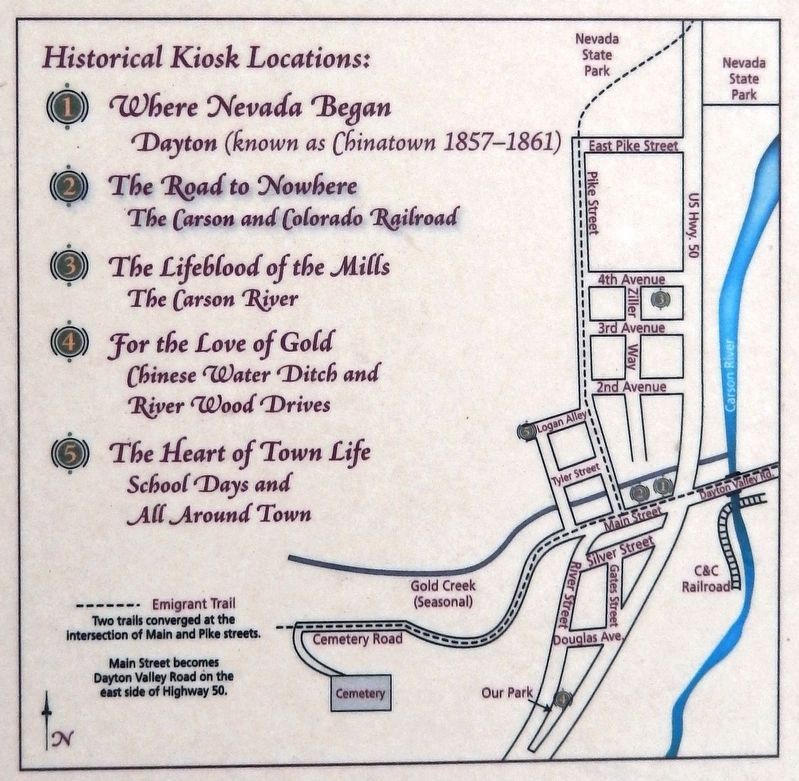
11. Marker detail: Historical Kiosk Locations
Dayton's history is exciting! Learn more — visit the Dayton Museum. Pick up a self-guided walking tour brochure, souvenirs, books on Dayton's history, and stories about settling Nevada and the Old West. For open hours, call 775-246-6316 or visit the Historical Society of Dayton Valley's website at www.daytonnvhistory.org.
Credits. This page was last revised on November 27, 2020. It was originally submitted on November 24, 2020, by Cosmos Mariner of Cape Canaveral, Florida. This page has been viewed 264 times since then and 35 times this year. Photos: 1, 2, 3, 4, 5, 6, 7, 8, 9, 10, 11, 12, 13. submitted on November 27, 2020, by Cosmos Mariner of Cape Canaveral, Florida.
